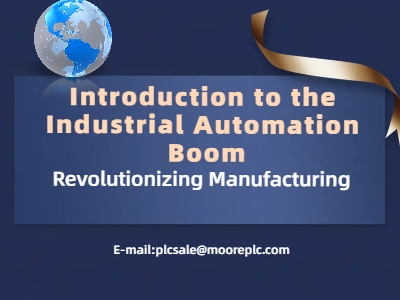Pasaran automasi industri global berada pada trajektori pertumbuhan yang luar biasa, dijangka mencecah $265 bilion menjelang 2025. Lonjakan ini boleh dikaitkan dengan peningkatan penggunaan teknologi termaju seperti senjata robot dan sistem automatik merentas pelbagai industri. Pemacu utama di sebalik pertumbuhan ini ialah kebangkitan Internet Industri Perkara (IIoT), yang menyediakan cerapan masa nyata dipacu data dan membuka pintu untuk jentera pembetulan kendiri berasaskan AI. Dalam artikel ini, kami akan meneroka transformasi menarik yang berlaku dalam automasi industri, dan pengaruh kuat robotik dan teknologi automasi merentas sektor pembuatan yang berbeza.

Automasi industri telah mencapai kemajuan yang ketara, berkembang daripada mekanisasi mudah kepada penyelesaian yang didorong AI yang canggih. Robotik, yang dahulunya terhad kepada segelintir aplikasi, kini disepadukan ke dalam hampir setiap aspek pembuatan, daripada barisan pemasangan kepada kawalan kualiti dan pembungkusan. Apabila syarikat ingin menyelaraskan operasi dan mengurangkan kesilapan manusia, automasi terus membentuk semula kemudahan pengeluaran dengan meningkatkan produktiviti, ketepatan dan keselamatan.
Penggunaan senjata robotik dan sistem pintar telah membawa kepada pembangunan proses pembuatan yang lebih fleksibel dan tangkas. Inovasi ini membolehkan industri bertindak balas dengan lebih pantas kepada permintaan pasaran, mengurangkan kos dan meningkatkan kualiti produk—semua faktor penting untuk kekal berdaya saing dalam ekonomi global yang pantas hari ini.
Pemangkin utama untuk penggunaan meluas automasi dan robotik ialah Internet Industri Perkara (IIoT). Dengan menyambungkan mesin, penderia dan sistem, IIoT membolehkan komunikasi dan perkongsian data yang lancar di seluruh tingkat pengeluaran. Ketersambungan ini memudahkan penyelenggaraan ramalan, pemantauan masa nyata dan membuat keputusan yang lebih baik.
Cerapan terdorong data yang disediakan oleh IIoT membantu pengeluar mengesan ketidakcekapan, meminimumkan masa henti dan memaksimumkan output. Penyepaduan pembelajaran mesin dan kecerdasan buatan meningkatkan lagi keupayaan IIoT, membolehkan mesin membetulkan sendiri, menyesuaikan diri dan belajar daripada data operasi. Sistem pintar ini boleh menjangkakan potensi masalah dan melaraskan proses secara automatik untuk mengekalkan prestasi optimum.
Walaupun terdapat kemajuan yang luar biasa, menyepadukan robotik dan automasi ke dalam pembuatan bukan tanpa cabarannya. Pelaksanaan yang berjaya memerlukan perancangan yang teliti, pelaburan strategik dan mengatasi halangan teknikal. Beberapa halangan yang paling biasa termasuk:
Walaupun menghadapi cabaran ini, faedah jangka panjang automasi dan robotik—seperti peningkatan kecekapan, keselamatan yang dipertingkatkan dan pengurangan kos buruh—sering kali mengatasi halangan awal.
Beberapa industri sudah pun meraih hasil automasi dan robotik. Sektor-sektor ini termasuk:
Industri-industri ini menyaksikan sendiri kuasa robotik dan automasi, dengan peningkatan ketara dalam kecekapan operasi dan piawaian keselamatan.
Apabila revolusi automasi berterusan, masa depan pembuatan kelihatan semakin pintar dan berhubung. Robotik dan IIoT akan menjadi penting dalam membantu industri bergerak ke arah sistem kawal selia kendiri yang automatik sepenuhnya, mengurangkan keperluan untuk campur tangan manusia dan memaksimumkan prestasi operasi. Memandangkan lebih banyak industri mengguna pakai teknologi ini, kita boleh menjangkakan inovasi selanjutnya yang akan terus membentuk landskap pembuatan pada tahun-tahun akan datang.
Revolusi automasi perindustrian sudah tiba, dan impaknya terhadap pembuatan tidak boleh dilebih-lebihkan. Dengan robotik dan Internet Perindustrian Perkara yang menerajui pertuduhan, syarikat dapat meningkatkan kecekapan, meningkatkan keselamatan dan mencapai produktiviti yang lebih tinggi. Walaupun cabaran wujud dalam penggunaan dan penyepaduan teknologi ini, faedahnya jauh melebihi halangan. Semasa kita melihat ke hadapan, automasi dan robotik akan terus mentakrifkan masa depan pembuatan, menjadikan industri lebih pintar, lebih tangkas dan bersedia untuk menghadapi cabaran masa depan.
Jika anda memerlukan lebih banyak produk dialu-alukan untuk menghubungi kami!
Emel :plcsale@mooreplc.com